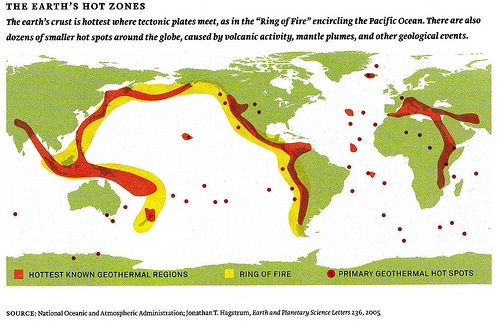Disadvantages
Although geothermal energy defiantly has a positive side, there is however drawbacks attached to this energy source. One of which is that in order for it to be harnessed into electrical energy, the hottest waters have to be used. Thus, it has to be near fault lines, which limits to which areas can make use of this resource to a larger extent.

Only certain areas on earths surface have the full potential to make the best use of geothermal energy.
Another draw back is the amount of effort, time and money that needs to be put in beforehand in order to build a geothermal power plant.The place where the plant will be built has to be carefully analyzed and tested to determine if it truly is a suitable spot. Then when a spot is finally chosen, just to dig deep into earths crust can cost up to one million dollars! Another inconvenience is the amount of noise that is released when these plants are in function, it is so loud that it is often compared to an aircraft taking off. Not to mention, the underground water contains minerals and gases that can be corrosive or produce a strong sent similar to rotten eggs!
Another negative impact is that as earth’s natural water is being pumped out to harness geothermal energy, scientists fear that this may cause the water table levels to be disturbed and fall, causing the land on top of it to shrink and sink due to the loss of water. Others argue that before the water tables levels could have a chance to fall, they would dry up, as earth’s energy is being taken up so quickly, that it would not have a chance to reheat the water that is being pumped back in.

The Planning and construction process that needs to be put in for building a geothermal energy plant is very costly.
A less impacting yet noticeable disadvantage is that these power plants can smell like rotten eggs!
